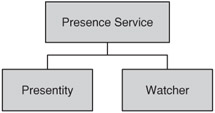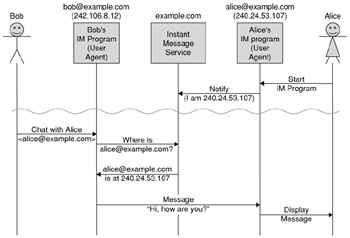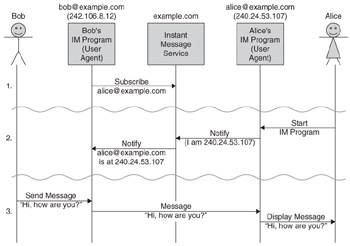Chapter 2: Location, Presence, and Privacy
This chapter describes how location information is produced, transported, and consumed on the Internet. This includes the presence model and the GEOPRIV abstract model for location services and privacy.
Presence
A presence service provides a way of accessing information about an individual's status. This is possible because an individual publishes information about themselves to the service so others can acquire that information.
Presence evolved from instant messaging services, providing users with a way of finding where their friends were on the Internet. Presence information for instant messaging includes details on how to contact a user-that is, whether they are online and what their current network location is. Since this initial form, a range of presence applications have been defined and presence is now used to convey a wide range of user data.
The Presence Model
The presence model is defined in Reference 1 (at the end of the chapter) by three roles: a presentity, a presence service, and a watcher. Figure 2.1 shows this very simple model.

Figure 2.1: The presence model.
The presence and GEOPRIV models are abstract concepts, which means that the ideas they define do not always directly relate to real-world concepts. Instead, they define a set of roles and the interactions between those roles. Each role is defined by a set of tasks that it performs. When an abstract model is applied to a real situation, each participant assumes one or more roles.
The presence service is a server that is the critical component in the system. It stores presence information and manages how that information is granted to users. The presence service is also responsible for protecting user privacy by limiting access to presence information.
The term presentity was coined to refer to the subject of a presence service; a presentity is the subject of presence information.
A presentity is identified by a presentity identifier, which is very much like an e-mail address-for example, alice@example.com. The presentity identifier is made globally unique by having the presence service allocate a name that includes the domain name of the presence service. Having the domain name of the presence service also means that if the name is known, the presence service can automatically be found.
A watcher is someone, or something, that is interested in the status of a presentity.
Example: Presence in Instant Messaging
When Alice starts her IM program, it publishes information about her presence to the presence service.
Bob wants to send his friend Alice an instant message (IM). Bob knows Alice by her name alice@example.com, so he uses that name to identify Alice to his instant messaging program. Bob's IM program then contacts the presence service at "example.com" to ask where it can contact alice@example.com. After ensuring that Bob is allowed to have this information, the presence service then tells Bob's IM program how to contact alice@example.com. Bob's IM program can then send the message to Alice's IM program.
Internet telephony services now widely use presence so that users are able to contact each other.
In IP telephony, the presence service is often called a Registrar, which is a reference to the way that the presence service assigns names. The term Location Server is also used in some cases, where "location" refers to network location; however, the term Location Server can be misleading, particularly since it has a different meaning when it comes to physical location, hence this term is no longer widely used.

Subscriptions
Presence information may be acquired in a number of ways by a watcher. In the most simple use of presence, the watcher may fetch the information whenever it is required. If a watcher only fetches the information, this limits the possible applications of presence. Most instant messaging programs continually display the status of buddies, but if this information changes, the program is unaware of this until it requests the information.
A watcher can subscribe to the presence service for a particular presentity. The presence service then notifies the watcher if the presence information for that presentity changes for any reason.
A subscription enables immediate action when presence information changes. Typical actions include a notification to the user, as either a discrete message or a brief sound. This immediate action is why subscriptions are favored for presence applications.
Example: Subscriptions for Instant Messaging
A subscription means that Bob can be notified immediately when Alice becomes available.
-
Bob's IM program subscribes to Alice's presence information.
-
Alice starts her IM program and becomes online. The IM program notifies the presence service. The presence service then sends a notification to Bob's IM program.
-
Bob can now see that Alice is online, so he sends her an instant message.

The Presence Document
The Presence Information Data Format (PIDF) is a document format defined by the IETF in Reference 2 for the representation of presence information. PIDF is a structured document that uses an XML format.
All presence documents contain a presentity identifier in the form of a Universal Resource Identifier (URI). Presence information, or status, is contained within one or more tuples. Each tuple can also include contact information and any other information relating to the given status, such as a time when the information was generated.
The following PIDF document indicates that alice@example.com is available (her status is "open") and that she may be contacted at the given Session Initiation Protocol (SIP) URI.
<?xml version="1.0"?> <presence xmlns="urn:ietf:params:xml:ns:pidf" entity="pres:alice@example.com"> <tuple > <status> <basic>open</basic> </status> <contact>sip:alice@240.24.53.107</contact> </tuple> </presence>
Using Presence for Location Information
A physical location can be considered part of presence information in much the same way as a user's online status or any other type of presence information. However, providing physical location as a part of presence introduces some challenges.
Subscription, which is the most powerful feature of the presence model, is inherently suited to discrete-valued data. Location is a continuous datum, which can also change continuously. This could result in an enormous number of notifications from the presentity or presence service.
One method for limiting the number of notifications is to prevent subscription and thus force watchers to fetch location information. Watchers must then poll the presence service to receive updated location information.
Alternatively, the watcher can limit the conditions where the presence server sends notifications. This provides a limit to the notifications without removing some of the advantages of presence. The drawback to this approach is that the presence server must still be aware of changes in location.
Another aspect of this problem is that location information is sometimes quite costly to determine in regards to time, processing capacity, and other resources. In these situations, location should only be determined when it is necessary to avoid incurring these costs.
For instance, a typical autonomous Global Positioning System (GPS) unit can take 15 seconds to determine a location when it has current satellite data; when no such satellite data is available, location determination can take up to 45 seconds. In addition to this time, determining a GPS location is processing-intensive, which can drain the batteries of a mobile device. Assisted GPS mitigates these costs by providing satellite data and performing the calculation phase on dedicated servers.
Subscription-based services offer applications greater flexibility, and are the core of future location-based services. To reduce the costs associated with location determination, it is the responsibility of the location service to appropriately limit how often location is determined, or to use less costly alternative methods. In many situations, the precision that GPS provides might be unnecessary, so quicker and cheaper methods can be used.
EAN: 2147483647
Pages: 129